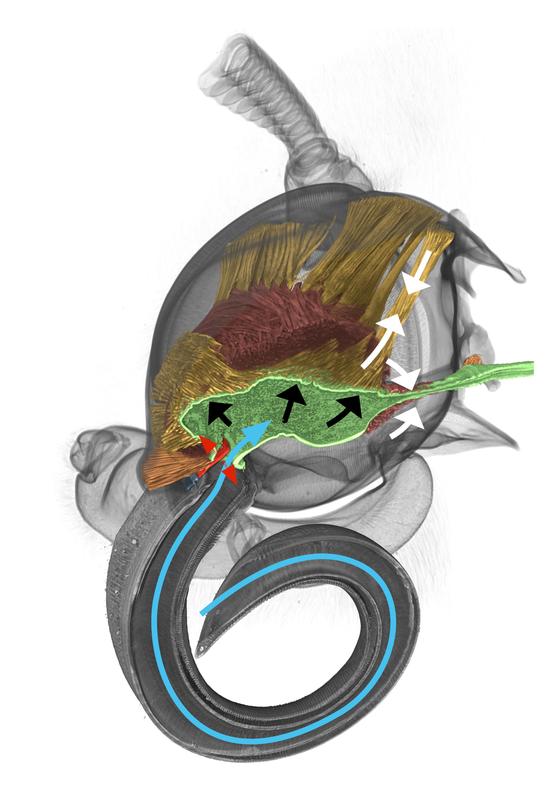A Fluttering Accordion

3D-reconstruction of a head of a Death's head hawk moth based on computer tomograph data. Illustration: Phyletic Museum/FSU Jena
Their arrival used to be perceived as a bad omen: Because of their scull-like markings on their backs the Death's head hawkmoths (Acherontia atropos) were dreaded. And yet, the big moth with the dark forewings and the beige-yellow marking is unusual for more than one reason: The animals migrate annually from Africa to Europe and visit beehives from which they steal honey with their short proboscides.
If the moths are irritated, they produce series of short squeaks. Scientists from the Universities Jena and Kiel, the Ernst-Abbe-Hochschule Jena and the University Hospital Jena (all Germany) looked into their unique way of producing sounds. The results of the joint research have now been published in the sience magazine 'The Science of Nature' (DOI: 10.1007/s00114-015-1292-5).
“The Death's head hawkmoth produces its sounds in a similar way to an accordion,“ explains Dr. Gunnar Brehm, who was in charge of the research. The folded top of the moth's pharynx is pulled up by muscles. Thereby a vacuum is created, so that air is drawn in.
The air then streams in through the moth's proboscis and mouth and thus triggers the vibration of a small lobe, whereby a sound is produced. Afterwards the air is being expelled, whereby another whistling sound is produced. The inflation and deflation though happens much quicker than in an accordion – it just takes a fifth of a second.
The team of scientists looked into the production of these sounds with the help of computer tomographs, a mammography device and with high speed cameras. The pictures impressively show the inside of the head of the moth, which mainly consists of the pharynx and muscles. In addition, the moths were examined in an acoustics laboratory, where the scientists discovered that the moths create sounds that can be heard by humans as well as in the ultrasound range to over 60 kilohertz. The moth's proboscis thereby serves as the resonating body.
With their squeaks, the scientists assume, the moths are trying to scare off predators. This at least works with humans, as the zoologist Brehm notes: Those who unknowingly touch one of the moths, withdraw their hand intuitively once the moth starts to move and squeak. This could be a small, selective evolutionary advantage. “It actually makes you wonder why other moths and butterflies don't squeak, because anatomically Death's head hawkmoths are very similar to their non-squeaking relatives,“ according to Brehm.
The reason for the scientific co-operation was the current special exhibition at the Phyletic Museum of the Jena University which is titled 'Folds in Nature and Technique'. The show also points out parallels between nature and technique using the example of musical instruments. The exhibition will be running until the beginning of September in Jena.
Original Publication:
Gunnar Brehm, Martin Fischer, Stanislav Gorb, Thomas Kleinteich, Bernhard Kühn, David Neubert, Hans Pohl, Benjamin Wipfler, Susanne Wurdinger: The unique sound production of the Death’s-head hawkmoth (Acherontia atropos (Linnaeus, 1758)) revisited, The Science of Nature (Naturwissenschaften), DOI 10.1007/s00114-015-1292-5
Contact:
Dr. Gunnar Brehm
Friedrich Schiller University Jena
Institute of Systematic Zoology and Evolutionary Biology with Phyletic Museum
Vor dem Neutor 1
07743 Jena
Germany
Phone: +49 / 3641 / 949184
Email: gunnar.brehm[at]uni-jena.de
Media Contact
All latest news from the category: Life Sciences and Chemistry
Articles and reports from the Life Sciences and chemistry area deal with applied and basic research into modern biology, chemistry and human medicine.
Valuable information can be found on a range of life sciences fields including bacteriology, biochemistry, bionics, bioinformatics, biophysics, biotechnology, genetics, geobotany, human biology, marine biology, microbiology, molecular biology, cellular biology, zoology, bioinorganic chemistry, microchemistry and environmental chemistry.
Newest articles

Bringing bio-inspired robots to life
Nebraska researcher Eric Markvicka gets NSF CAREER Award to pursue manufacture of novel materials for soft robotics and stretchable electronics. Engineers are increasingly eager to develop robots that mimic the…

Bella moths use poison to attract mates
Scientists are closer to finding out how. Pyrrolizidine alkaloids are as bitter and toxic as they are hard to pronounce. They’re produced by several different types of plants and are…

AI tool creates ‘synthetic’ images of cells
…for enhanced microscopy analysis. Observing individual cells through microscopes can reveal a range of important cell biological phenomena that frequently play a role in human diseases, but the process of…





















